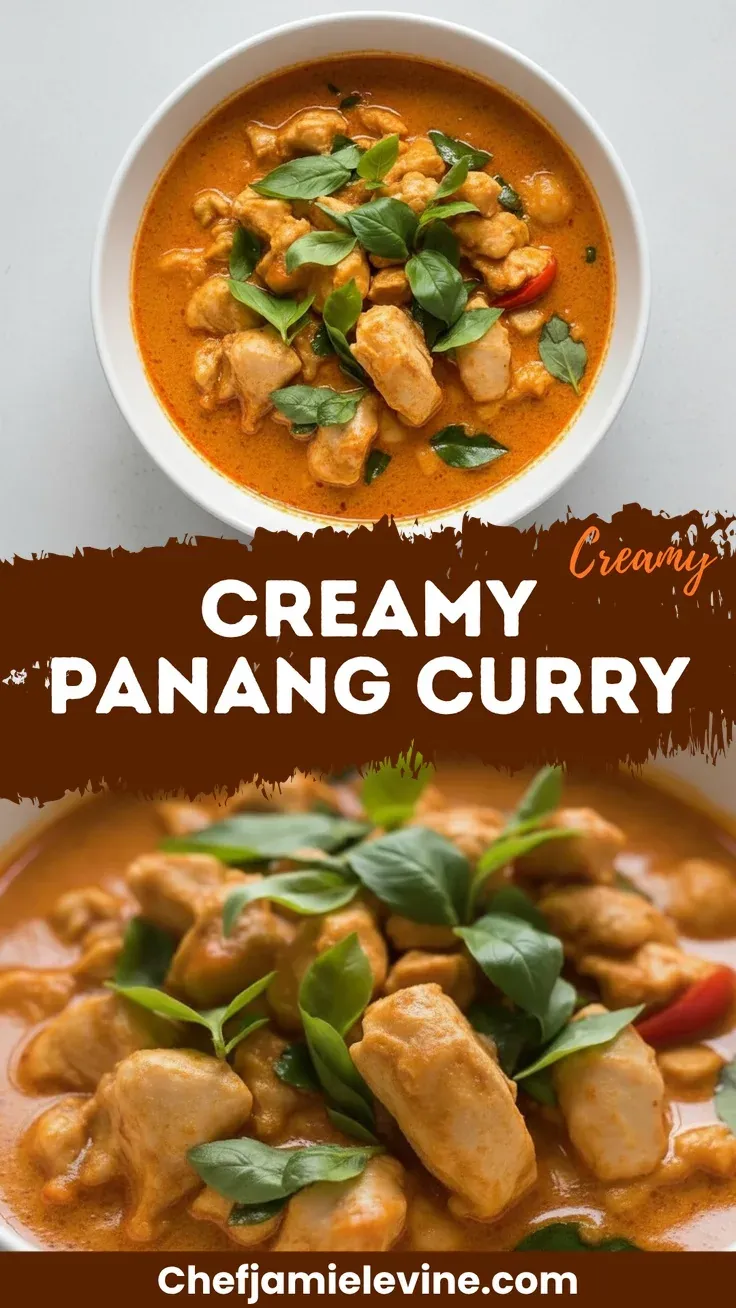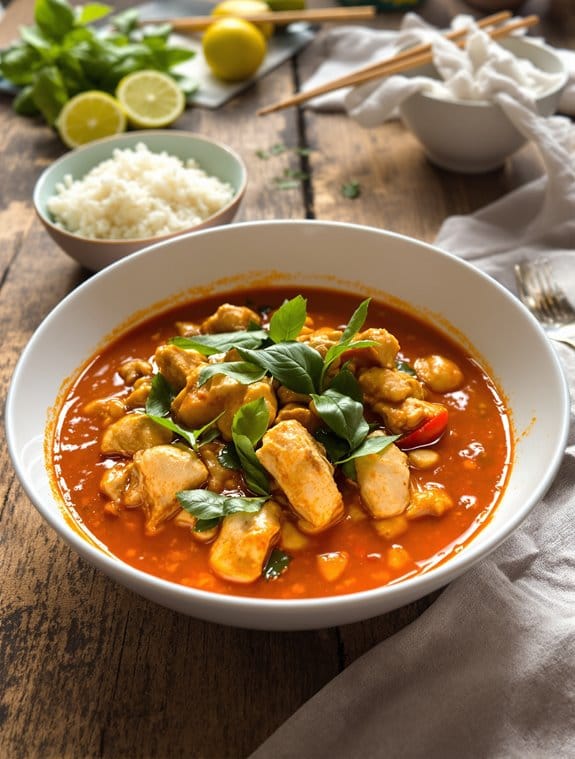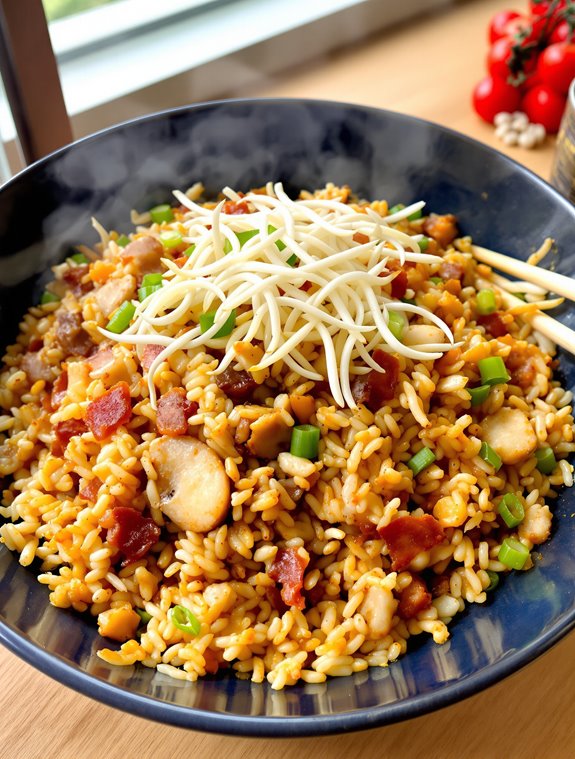Why You’ll Love this Creamy Panang Curry
Why have I been obsessed with this Panang curry for years? Simple—it’s the perfect balance of creamy, spicy, and slightly sweet that transforms an ordinary weeknight into something special.
The velvety coconut milk creates a sauce so rich you’ll want to drink it straight from the pan (trust me, I’ve considered it).
What makes this recipe a keeper is its adaptability. Too spicy? Reduce the curry paste.
Need more protein? Double the chicken. It’s ready in under 30 minutes, making it faster than delivery but tasting like you’ve simmered it all day.
What Ingredients are in Creamy Panang Curry?
Creating this luscious Panang curry at home requires surprisingly few ingredients to achieve that restaurant-quality flavor.
The secret lies in the balance between the creamy coconut milk and the aromatic curry paste, which together form the foundation of this Thai classic.
I always recommend using full-fat coconut milk for the richest texture—the kind that separates in the can with a thick cream layer on top. That’s flavor gold right there.
- 1 pound boneless chicken breast, cut into bite-sized cubes
- 13½ ounces coconut milk
- 8 ounces Panang curry paste
- 2 tablespoons fish sauce
- 2 tablespoons basil leaves
- 2 tablespoons palm sugar
While these ingredients form the core of our Panang curry, don’t be afraid to make adjustments based on what you have available.
Can’t find palm sugar? Brown sugar works in a pinch, though it lacks some of the caramel notes.
The recipe doesn’t mention lime leaves specifically in the ingredients list but references them in the cooking process—they add a wonderful citrusy aroma if you can get your hands on them.
And remember, the curry paste varies in intensity by brand, so you might want to start with less and add more to taste, especially if you’re sensitive to heat.
Your curry, your rules.
How to Make this Creamy Panang Curry

Making Panang curry at home is surprisingly straightforward, and the results are absolutely worth it. Start by cutting 1 pound of boneless chicken breast into bite-sized cubes—this guarantees even cooking and makes the curry easier to eat.
In a medium to large skillet, pan-fry the chicken pieces until they’re almost done, but not completely cooked through. Once they’re nearly there, remove the chicken and set it aside. We’ll be returning to it shortly, and this two-step cooking method keeps the meat tender and juicy.
Now for the magical part—the curry base. Using medium heat, add 4 tablespoons of coconut milk (from your 13½ ounce can) to the same pan and bring it to a gentle boil. This creates the perfect environment to bloom your curry paste.
Add 2-3 tablespoons of Panang curry paste (from your 8-ounce portion) and stir to combine, allowing the aromatic spices to release their flavors. Can you smell that? It’s the scent of your kitchen transforming into a Thai restaurant.
Return the chicken to the pan and stir until it’s thoroughly cooked, allowing it to absorb those beautiful curry flavors.
The final steps are all about building layers of flavor and creating that signature creamy texture. Add half of the remaining coconut milk while continuing to stir, then incorporate 2 tablespoons of fish sauce and 2 tablespoons of palm sugar.
Pour in the rest of the coconut milk and allow the sauce to thicken slightly. Just before serving, stir in 2 tablespoons of fragrant basil leaves and some lime leaves if you have them.
Take a moment to taste your creation—you might need to adjust with a bit more fish sauce for saltiness or palm sugar for sweetness. The beauty of homemade curry is that you can personalize it exactly to your preference.
Serve your creamy Panang curry over jasmine rice, and watch as everyone at the table falls silent, too busy savoring each spoonful to speak.
Creamy Panang Curry Substitutions and Variations
While the authentic recipe creates a stunning curry, you’ll often find yourself needing to adapt based on what’s in your pantry.
Tofu or shrimp make excellent protein swaps for chicken—I’ve even used chickpeas in a pinch. Can’t find panang curry paste? Red curry paste with a tablespoon of peanut butter creates a similar flavor profile.
Brown sugar works perfectly if palm sugar isn’t available, and regular basil can substitute for Thai basil.
Vegetarians might skip the fish sauce and use soy sauce with a squeeze of lime instead.
And don’t worry if fresh lime leaves seem impossible to find—a bit of lime zest provides that citrusy note.
What to Serve with Creamy Panang Curry
A perfectly made panang curry deserves equally thoughtful accompaniments to round out your meal.
I always serve mine with jasmine rice—its subtle floral notes and fluffy texture are perfect for soaking up that creamy, spicy sauce. For a complete Thai experience, add some cooling cucumber salad on the side; the crisp vegetables provide a revitalizing contrast to the curry’s richness.
Want something more substantial? Try roti bread for dipping, or steamed vegetables like bok choy or broccoli.
I’ve found that a chilled Thai iced tea works wonders to temper the heat. Trust me, your taste buds will thank you for these thoughtful pairings.
Final Thoughts
After cooking this panang curry countless times for family and friends, I’ve come to appreciate its perfect balance of creamy richness and complex flavor.
What truly makes this dish special is how it transforms a regular weeknight into something memorable. No fancy equipment needed—just a few key ingredients and some patience.
Remember, cooking is about making it your own. Too spicy? Reduce the curry paste. Need more umami? Add an extra splash of fish sauce. Trust your taste buds, they rarely lead you astray.
Ready to impress someone? This curry might just become your signature dish.

Creamy Panang Curry
Ingredients
Equipment
Method
- Cut the chicken breast into bite-sized cubes to ensure even cooking.
- In a large skillet, pan-fry the chicken pieces until almost cooked through but not completely done. Remove and set aside.
- Using medium heat, add 4 tablespoons of coconut milk to the same pan and bring to a gentle boil.
- Add the Panang curry paste to the coconut milk and stir to combine, allowing the spices to release their aromas.
- Return the chicken to the pan and stir until thoroughly cooked, allowing it to absorb the curry flavors.
- Add half of the remaining coconut milk while continuing to stir.
- Incorporate the fish sauce and palm sugar, stirring to dissolve.
- Pour in the rest of the coconut milk and allow the sauce to simmer until slightly thickened.
- Just before serving, stir in the basil leaves and lime leaves (if using).
- Taste and adjust seasonings if needed, adding more fish sauce for saltiness or palm sugar for sweetness.
- Serve hot over jasmine rice.



